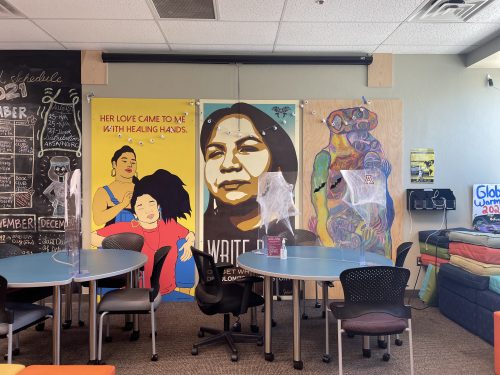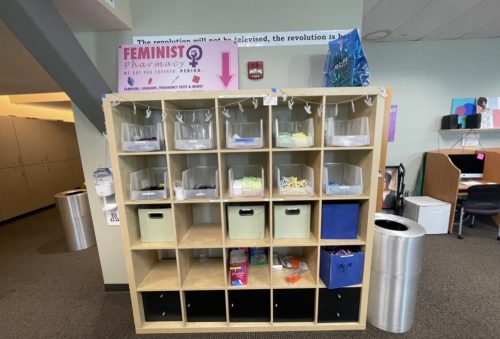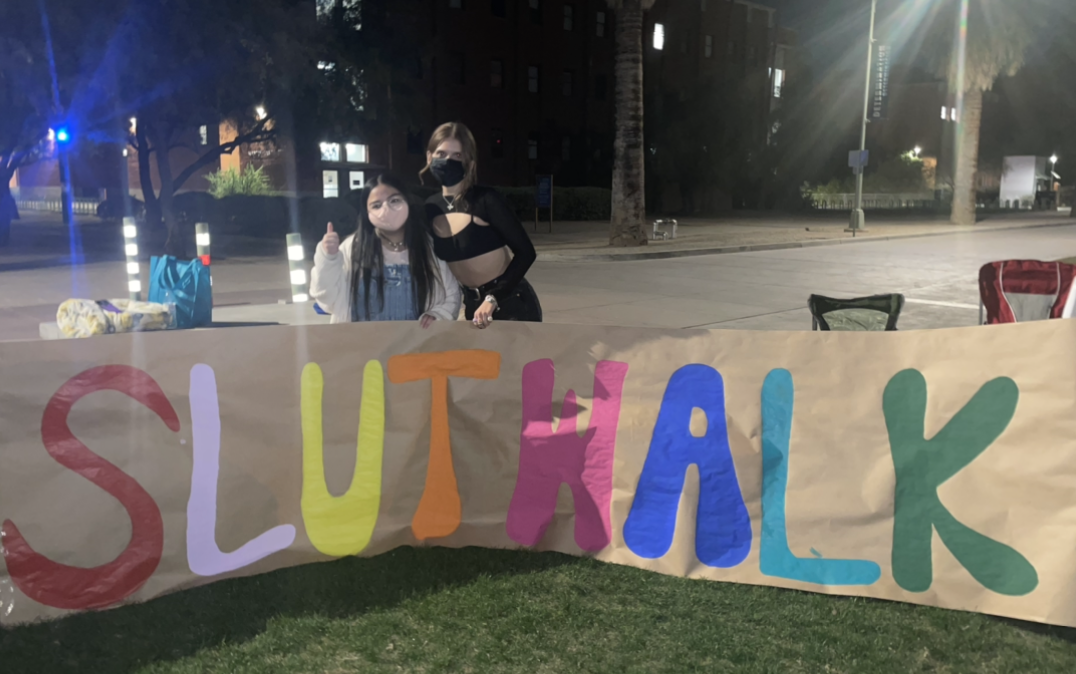By Margaux Clement/El Inde
Twelve-year-old Daniela Garcia scrolled through one of the most popular social media platforms at the time,Tumblr, while she and her friends would hang out. Sitting in bed at a friend’s house for a sleepover, walls dancing with fairy lights and covered completely with One Direction posters, she came across Charlotte Bronë’s quote from her feminist Jane Eyre novel, “I am no bird and no net ensnares me.”
Daniela thought the quote was badass and as she kept scrolling through Tumblr, the algorithm kept placing more feminist content on her page. Pink collages, artworks of vulvas and vaginas, and quotes by cis-gendered feminists were popping up more and more on her feed. Although she still recognized this content as feminism, this version was centered around white cis-gendered women. She couldn’t help but notice the lack of representation of women of color like herself.
Daniela is the daughter of Daniel and Michelle Garcia. She identifies herself as a queer Mexican-Filipino woman who is a first-generation college student at the University of Arizona, majoring in elementary education.
“Yes, I identify as a woman, but I also experience the world as non-white and queer person,” Daniela said, pointing out how mainstream feminism from past generations lacked an intersectional approach.
These days, Daniela co-directs FORCE (Feminists Organized to Resist, Create and Empower) on campus with 22-year-old Emerson Lampert Mayorga, who is from Phoenix, Arizona. Emerson’s majoring in both psychology and gender and women’s studies at the University of Arizona. Their goal is to create a safe space to learn and have community.
“[FORCE] may not be large scale in the sense that most people would imagine, (but) it’s still important and significant work because it’s creating that new norm of creating a safe space, asking for feedback, always making sure to acknowledge pronouns, being reflective and growing as individuals, leaders and feminists,” Emerson said.
“Me getting here today as co-director of the group is from a combination of all these little pieces of my life, and every piece of my life is in some way or another influenced from all the identities I have,” says Daniela.
Even in her early teen years, Daniela had experiences at Tucson High School that she described as making her “violently uncomfortable.” At school, the dress code for girls was 6 pages long, in contrast to the boys’ 1.5 page long list. And it was much more tedious: No shoulders, shorts and skirts must be of finger-length, no low-cut shirts, no crop tops, no tube tops, no halter tops, and so on.
Even in middle school gym class, while Daniela was dressed in a short-sleeve shirt, her teacher pointed out that her breasts were distracting the entire class because of her shirt. Daniela felt completely alienated when the gym teacher asked the whole class, out loud, “Isn’t she, boys?”
During high school, she had a white male teacher for two consecutive years who would consistently micro-agress, discriminate and show prejudice towards Daniela. He would stand up in front of the class invalidating her Filipino identity, listing off all the racial stereotypes of Asian and Pacific Islander people to compare how she did or didn’t fit them. Daniela shared that the teacher would question if Daniela was even Filipino, and joke that he was more “Filipino” than her because he was dating a Filipino woman.
“(He) was stereotyping me and fetishizing his girlfriend at the same time, which was wildly inappropriate. He did this to me all the f**king time,” Daniela added.
He had also forced the entire class to go around the room and share their racial identities one by one. Regardless, he taught a second language class and addressing racial identities was completely inappropriate and irrelevant to his lessons.
“It was crazy, because at this moment there was already a disparity in the power structures between us as BIPOC (Black, Indigenous, and People of Color) students and him as a white man (who) demanded to know our identities… If he didn’t understand, he felt we owed him an explanation.”
She didn’t allow these moments to affect her negatively, instead, she took this experience as a lesson for how she will never allow her future students to feel. Daniela plans to teach kindergarteners upon graduating. She aims to be an informative facilitator for her students and allow them to have open discussions as well as make up their opinions.
“Kids at that age don’t really understand context clues, subliminal messages or non explicit references. They need the opportunity to learn things, like cultures and identities, very explicitly. So, I think giving them the opportunity to ask questions and just hear about different things is all you can offer,” Daniela said.
Even though Daniela grew up in a demographically-diverse city like Tucson, the University of Arizona is a predominantly white space. This was a new environment for her. To find a sense of community at the big school, Daniela went through the clubs’ and organizations’ page on the UofA website, and eventually she stumbled across FORCE.
As you walk inside the Women’s and Gender Resource Center (WGRC) on the 4th floor of the Student Union, a desk attendant greets you with a smile and is ready to help with your needs. Keep walking, and you’ll find three rows of desks, Daniela’s and Emerson’s being the first in sight. Hanging above them are bright yellow sticky notes that serve as reminders of daily tasks that need to be tackled. You can find the two working side by side if they are not running around completing their tasks and meetings through the week.
Further inside, there is a shelving unit or “feminist pharmacy” with feminine products free for those in need. There’s also a couch area where the group will meet for events such as community conversations or “Sip-n-Bitches.”


(Photo by Margaux Clement)
“When you go into that space, you know there’s going to be a diverse group of people, and if there are white people there, you’re in a position that you’re supported in having a constructive dialogue with them,” Daniela said.
Daniela shared that feminism and activist work is not exclusively for women, and the WGRC is open for anyone and everyone who wants to come.
“You don’t have to be an expert or know everything, you just have to want to try and be open to learning and standing up to all the bullsh*t we go through everyday because of our identities, and also acknowledging that we hold different privileges as well,” Emerson said.
She is referring to the microaggressions and ways that a lot cis-white heterosexual men act towards any marganalized group outside their own because they benefit the most from our patriarchal society.
In Emerson’s case, this became obvious as she dealt with sexual harassment in every restaurant business she’s worked at since she was 17 years-old. If a man feels entitled to take up space on the sidewalk, fails to acknowledge Emerson and expects her to move- she’s going to say something. Also, if someone makes an offensive comment to her, she’s going to vocalize that it’s not okay back to them, Emerson added.
Every year, FORCE also holds the “Slutwalk,” a march through Tucson. This year, however, it was held on the University of Arizona mall as an event with public speakers, poets, booths with free condoms, education packets, and Plan B pills, in addition to free conchas, sandwiches, and drinks for attendees.

“I think as far as spreading campus-wide dialogue, our Slutwalk is a wonderful focal point for that. Yes, it does center people who have survived sexual violence or sexual assault but sexual violence is not purely sexual assault, it’s also sexual harassement which is inherently a violent thing to experience. I feel like giving that space and the opportunity to really feel community is empowering,” said Daniela.Tianna Fields, a 29-year-old black queer poet from Tucson, read some of her pieces for the crowd. She was dressed in white high-top Vans sneakers, short black shorts, and a black-and-white mesh top which showed off her white bra peeking through.
“I take Slutwalk seriously, we’re trying to show out a little bit and that’s that on that!” Fields said. “Know what you wear shouldn’t affect how other people treat you. Normally it’s very showy and flashy, one of the points is to be a little obnoxious, a little sexy and have fun with it.”
